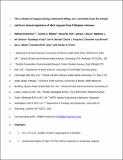The evolution of magma during continental rifting : new constraints from the isotopic and trace element signatures of silicic magmas from Ethiopian volcanoes
Abstract
Magma plays a vital role in the break-up of continental lithosphere. However, significant uncertainty remains about how magma-crust interactions and melt evolution vary during the development of a rift system. Ethiopia captures the transition from continental rifting to incipient sea-floor spreading and has witnessed the eruption of large volumes of silicic volcanic rocks across the region over ∼45 Ma. The petrogenesis of these silicic rocks sheds light on the role of magmatism in rift development, by providing information on crustal interactions, melt fluxes and magmatic differentiation. We report new trace element and Sr–Nd–O isotopic data for volcanic rocks, glasses and minerals along and across active segments of the Main Ethiopian (MER) and Afar Rifts. Most δ18O data for mineral and glass separates from these active rift zones fall within the bounds of modelled fractional crystallization trajectories from basaltic parent magmas (i.e., 5.5–6.5‰) with scant evidence for assimilation of Pan-African Precambrian crustal material ( δ18O of 7–18‰). Radiogenic isotopes ( εNd = 0.92 – 6.52 ; 87Sr/86Sr = 0.7037–0.7072) and incompatible trace element ratios (Rb/Nb <1.5) are consistent with δ18O data and emphasize limited interaction with Pan-African crust. However, there are important regional variations in melt evolution revealed by incompatible elements (e.g., Th and Zr) and peralkalinity (molar Na2O + K2O/Al2O3). The most chemically-evolved peralkaline compositions are associated with the MER volcanoes (Aluto, Gedemsa and Kone) and an off-axis volcano of the Afar Rift (Badi). On-axis silicic volcanoes of the Afar Rift (e.g., Dabbahu) generate less-evolved melts. While at Erta Ale, the most mature rift setting, peralkaline magmas are rare. We find that melt evolution is enhanced in less mature continental rifts (where parental magmas are of transitional rather than tholeiitic composition) and regions of low magma flux (due to reduced mantle melt productivity or where crustal structure inhibits magma ascent). This has important implications for understanding the geotectonic settings that promote extreme melt evolution and, potentially, genesis of economically-valuable mineral deposits in ancient rift-settings. The limited isotopic evidence for assimilation of Pan-African crustal material in Ethiopia suggests that the pre-rift crust beneath the magmatic segments has been substantially modified by rift-related magmatism over the past ∼45 Ma; consistent with geophysical observations. We argue that considerable volumes of crystal cumulate are stored beneath silicic volcanic systems (>100 km3), and estimate that crystal cumulates fill at least 16–30% of the volume generated by crustal extension under the axial volcanoes of the MER and Manda Hararo Rift Segment (MHRS) of Afar. At Erta Ale only ∼1% of the volume generated due to rift extension is filled by cumulates, supporting previous seismic evidence for a greater role of plate stretching in mature rifts at the onset of sea-floor spreading. We infer that ∼45 Ma of magmatism has left little fusible Pan-African material to be assimilated beneath the magmatic segments and the active segments are predominantly composed of magmatic cumulates with δ18O indistinguishable from mantle-derived melts. We predict that the δ18O of silicic magmas should converge to mantle values as the rift continues to evolve. Although current data are limited, a comparison with ∼30 Ma ignimbrites (with δ18O up to 8.9‰) supports this inference, evidencing greater crustal assimilation during initial stages of rifting and at times of heightened magmatic flux.
Citation
Hutchison , W , Mather , T A , Pyle , D M , Boyce , A J , Gleeson , M L M , Yirgu , G , Blundy , J D , Ferguson , D J , Vye-Brown , C , Millar , I L , Sims , K W W & Finch , A A 2018 , ' The evolution of magma during continental rifting : new constraints from the isotopic and trace element signatures of silicic magmas from Ethiopian volcanoes ' , Earth and Planetary Science Letters , vol. 489 , pp. 203-218 . https://doi.org/10.1016/j.epsl.2018.02.027
Publication
Earth and Planetary Science Letters
Status
Peer reviewed
ISSN
0012-821XType
Journal article
Description
This work was supported by the RiftVolc project (NE/L013932/1, Rift volcanism: past, present and future) and a NERC studentship (NE/J5000045/1) awarded to W.H. W.H. also received funding from the European Union's Horizon 2020 research and innovation programme under grant agreement No. 689909. C.V.-B. and I.M. acknowledge a BGS-NIGL Programme Project (40227) for Sr–Nd–Pb isotope analysis of the four samples from Dabbahu. C.V.-B. publishes with permission of the Executive Director of the British Geological Survey (NERC). Oxygen isotope analysis at SUERC was supported by a NERC Stable Isotope Facility grant (IP-1367-0513).Collections
Items in the St Andrews Research Repository are protected by copyright, with all rights reserved, unless otherwise indicated.

